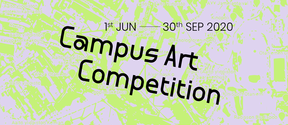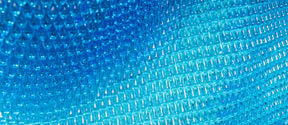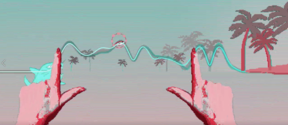Winners in the campusart competition rooted in bioart and quantum physics
Laura Piispanen, Noora Heiskanen, Jenna Ahonen and Ayda Grisiute convinced the jury with their creativity.

Aalto University launched an invited art competition in 2020, the aim of which was to get feasible proposals for works of art found on the Otaniemi campus. There were two winning entries: bio.modules.way and Quantum Moss. The first arrived at the Otaniemi campus in August, and the latter is now installed next to the metro entrance of shopping centre A Bloc.
Designed by Aalto student Noora Archer and researcher Laura Piispanen, Quantum Moss is a pergola-type work, built from Finnish pine plywood, whose design language is based on a numerical simulation of the probability distribution of the position of a quantum mechanical particle in relation to time. The meandering, largely symmetrical pattern of the work tells how the "position" of a particle behaving like a wave would vary along a vertical, defined axis. The deepest points in the form represent the peak points of the probability distribution at different moments in time.
'Through our work, we wanted to bring together at least two of Aalto's world-class areas of expertise: quantum technology research and wood construction', says Piispanen. Archer and Piispanen are particularly united by a passion for information visualisation and the artistic communication of science. Visualising quantum physics through art is a central part of both Piispanen's doctoral thesis and Archer's master's thesis.

For viewing the work, Archer gives a tip from a non-physicist's point of view: 'If you find the places where the holes in the work can be seen completely through, you know where the particle is most likely to exist.'
The artists say that the work is intended to be admired from a distance of 3–5 meters, but it can also be viewed very close. Passers-by can also sit on a bench and take a breather at the work in the middle of the busy campus area.
'We had the idea of a work, a wall, which punches a hole between the visible world and the invisible small quantum world and awakens curiosity in the viewer's mind towards the fragile beauty of our natural world. We really liked the narrative approach, where the body of our piece becomes a kind of quantum physics stage, where the show progresses slowly over the course of seasons and years', describes Archer.
Archer and Piispanen say that they are proud that Quantum Moss is a truly interdisciplinary work, realised through enabling interactive research. They wanted to offer as many interested parties as possible the opportunity to collaborate, so a large forestry group as well as Master's students from Aalto participated. During the project, the artists founded a company, Kiedos.ART, studying entrepreneurship in addition to their programme and research topic studies related to the art project.

The naturally growing moss in the vicinity of the metro block has recently been removed due to street works in the area between Korkeakouluaukio square and the Harald Herlin Learning Centre. Quantum Moss contributes to bringing nature back to the area. The work can be enjoyed by passers-by, but also by the area's animals, insects, microbes and other vegetation in urban nature. The porous surface structure of Quantum Moss provides both building material and protection for various insects.
'By better understanding the natural growth and life of mosses in an urban environment, we also learned how important the surrounding microclimate and the moisture and protection that enable growth were for them as living beings. When our work got a place next to the historic linden alley on campus, we were really happy!' say Archer and Piispanen.
The outdoor artwork is made of 50 mm thick pine plywood. With the wind, moss spores fly over the work, gradually turning the work green with moss. Over time, the external form of the work changes again, as part of the decomposition of the parts of the work, merging with nature and the growth and withering of moss, algae and other growths.
Due to the choice of materials for the piece, Quantum Moss has an unusually short life cycle for a public artwork, which enables the natural diversity of the Otaniemi campus area to be increased in a sustainable way. With this, the work also brings the environmental costs of public art into the discussion.
'Nature often does not follow people's schedules. However, our work would be constantly changing, as the first microbes would probably move into it first from that day on, starting to finally build its parts visible to the human eye. In our opinion, this was exactly what the campus art competition was looking for: radical and sustainable creativity', the artists say.
|
Assisted in the design and implementation |
In 2017, Aalto University decided to comply with a one per cent art principle in its building projects. The campus art competition is the university’s fifth project, where approximately one per cent of a building project's allocation is allocated to art purchases. The one per cent art principle was first applied to the Radical Nature art concept in Aalto University’s main building, Dipoli.
The vision of public art at Aalto University is to address and raise questions about what it is to be a university, what we do together in society, and what constitutes the public. Public art is site-specific and connects with the diversity of the university and its post-disciplinary communities. Public artworks reflect this diversity through different art forms, materials, techniques and traditions.
More information
Outi Turpeinen, Senior Specialist, art and exhibitions
[email protected]
tel. 050 431 4194
Noora Archer, Kiedos.ART
[email protected]
Laura Piispanen, Kiedos.ART
[email protected]

Laura Piispanen, Noora Heiskanen, Jenna Ahonen and Ayda Grisiute convinced the jury with their creativity.

The aim of public art across Aalto is to create a vibrant environment for experiencing the world through various perspectives and for embracing imagination, intuition, and exploration.
Campus art competition winner bio.modules.way will be installed next to Dipoli

Games help to demystify quantum physics, says Laura Piispanen, the organizer of Quantum Game Jam, whose interest led her to work on a doctoral thesis on the subject.


